- 易迪拓培训,专注于微波、射频、天线设计工程师的培养
电源技术已经准备采用数字技术(英)
Digital power-supply control has certainly captured the attention of the power electronics industry during the last 18 months. It has gone from papers presented in those "catch-all" sessions at power conferences to having its own sessions and even its own conference.
What has happened to raise digital power from an interesting student project to an active market segment?
Power supplies and microcontrollers are not strangers. Micros have been monitoring and supervising power for quite some time. When power supplies became more complex, with multiple rails to synchronize, dedicated solutions were developed. When systems demanded more information from the power subsystem, designers provided custom communications to meet those requirements. In many ways, it seems that digital power is a "been there, done that" topic. So, what’s new that justifies more attention than what digital power has already received?
For many years, the evolutionary pace of power design—driven by the need to meet the application requirements—stayed "just ahead" of the evolution of digital control solutions. Today’s catalog digital controllers can close loops for 100-kHz switching power supplies with 50% duty cycles at 2% regulation. However, that is not what today’s power supplies require.
The industry needs solutions to support switchers with frequencies greater than 1 MHz at 10% duty cycles and demanding 0.5% regulation. And, those are just today’s requirements. To meet tomorrow’s requirements for higher switching frequencies, greater improvements to PWM specifications are required.
Starting down the road to digital power solutions requires significant preparation and investment. The power electronics industry must have a high degree of confidence that this investment will yield high returns well beyond the next few years. After talking about the benefits of digital loop control in power for years, the circuits needed to support the now practical demands.
This does not mean that the 3842 pulse-width modulator should be placed on the endangered IC list. Digital power has a ways to go before that happens. Yet where levels of complexity and flexibility are important to the success of the power-supply design, certain integrated digital solutions recently have been introduced to meet the needs for high PWM resolution without the need to have a gigahertz clock.
In today’s world, it is not good enough to have acceptable efficiency in a narrow operating range. Many systems require high efficiency across a broad range of loads. In addition, the transition from a light load to full load is becoming faster and faster. So, the power supply must quickly adapt to the system’s needs. Digital power solutions provide the flexibility to meet these requirements. The ability to have the choice of several control laws, including non-linear control, permits adaptive responses.
Other emerging power industry activities make digital power solutions more attractive to system customers. The PMBus (Power Management Bus) initiative aims to define a standard protocol that meets the required utility and carries the necessary specification rigor so system software developers feel confident integrating it into improved power management.
Investments in software development must have reasonably long periods between software revisions. In addition, the data exchanged must have a positive system impact on the total system operation and reliability. Both the system and power supply must exchange "actionable" information. This allows both system and subsystem to optimize the total power environment.
What has changed to make digital power so timely? The power electronics industry sees that the industry is important enough to demand power-specific digital control solutions. It also knows that the complexity of power-supply design is increasing, and digital methods address this issue. Standards help promote power-supply information and allow reuse across multiple end-equipment spaces. Digital design and advanced process technologies have finally surpassed today’s power solution requirements. Further investment in developing digital skills and solutions will yield many happy returns for designers.
See Associated Figure
Figure 1

